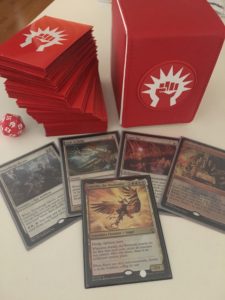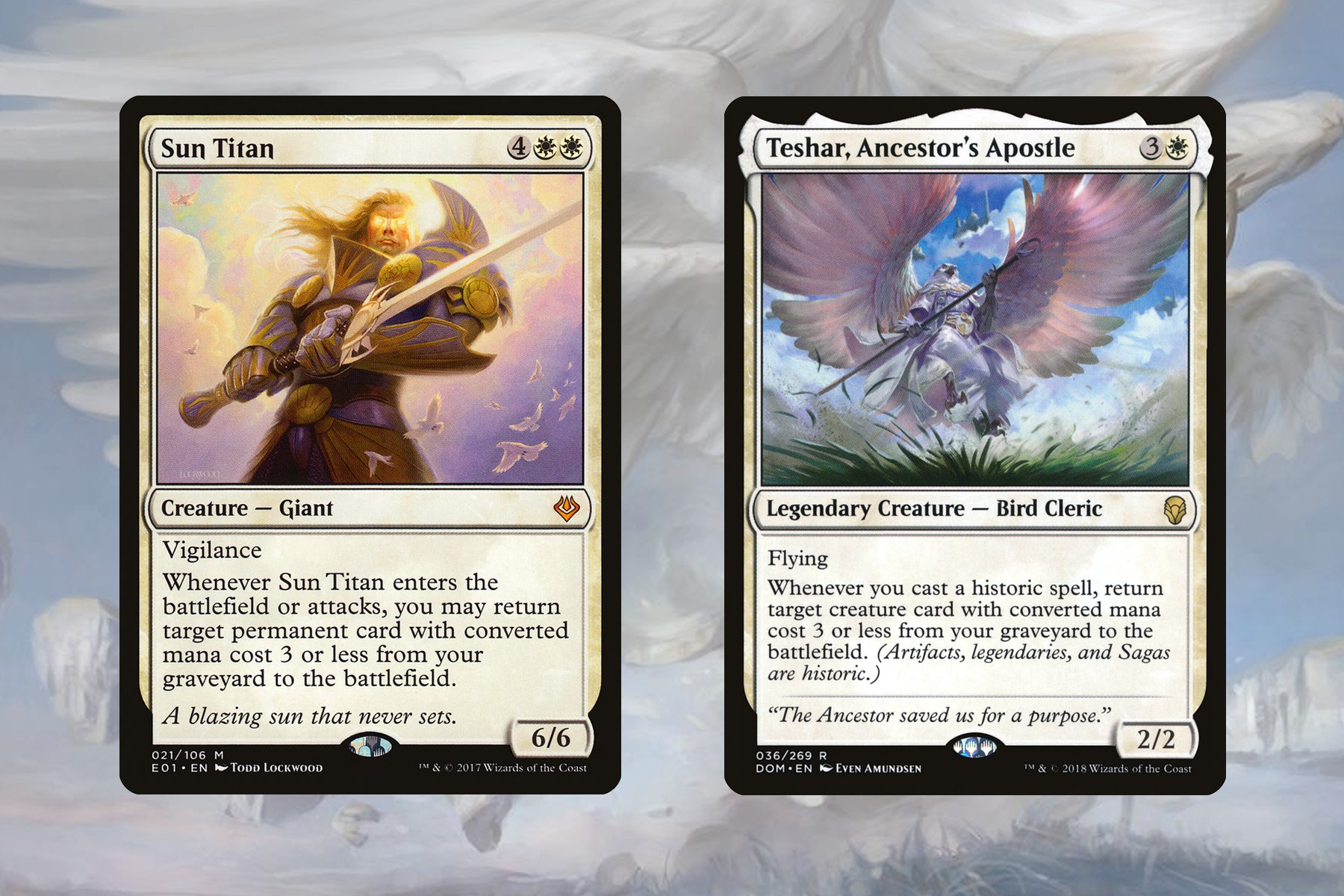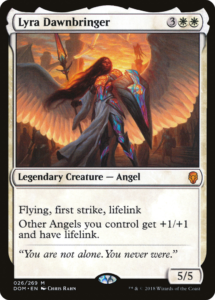This week, Legion’s Landing looks at how recursion can support one of the ‘lesser’ color pairs in magic, Boros. We’ll dive into how to construct a powerful, explosive and resilient deck using what we’ve explored so far. If you’d like a primer on Recursion, check out the first part of the series.
As the de facto head of the UK garrison of the Boros Legion, I feel it’s only good and proper to bring a Boros perspective to the table as we talk about recursion. I’ve been playing Aurelia since I got into the game, and what started as a pile of jank has since evolved into my go-to deck—check Travis’s article out to see which category you think it fits into.
So, recursion is easy in decks playing Black and Green, but how about in colors that don’t have such an easy time? White actually has a decent amount of recursion, but some of it is either less obvious, or harder to pull off. Cards like Sevinne’s Reclamation are heading in the right direction, but you’d be surprised what we currently have access to. Let’s get into it.
A Wheely Good Time
The first thing I’d like to talk about is the power of wheels. Being able to draw a fresh seven cards in Red or White is a dream come true—we’re often only able to draw only in increments of one. Cards like Wheel of Fortune, Reforge the Soul, and Runehorn Hellkite let us do just this. The downside, of course, is giving your opponent a fresh hand, too. This can be mitigated somewhat by the density of answers in your deck. Red and White can play a lot of answers, and there’s a good chance you draw into one or more when you fire off a wheel effect.
So, what do Wheels have to do with recursion? Well, simply put, they can be used to set up our graveyard with targets for some of White’s various recursive effects. Karmic Guide, Sun Titan, and Bruna, the Fading Light are a few we all know. Red can also benefit from this, in that they can recur artifacts. Cards like Goblin Welder, Goblin Engineer, Trash for Treasure, and Scrap Mastery can also benefit from this effect. In this way, both Red and White can cheat on mana, and get some expensive cards into play with explosive effectiveness.
If you want to turn this up to 11, you can add Smothering Tithe. This is one of the strongest strategies to emerge this year, as Smothering Tithe can generate up to 21 Treasure per wheel cast if your opponents are unable or unwilling to pay the cost. If you draw into another wheel effect, you can chain these effects together and gain some serious advantage.
Using this engine does shift your deck in a particular way, though—if you’re planning on using this strategy, I would advise on building your deck to be able to cope with having its resources in the graveyard. One spell I really like in this strategy is Marshal’s Anthem. The multikicker on this is generally quite expensive, with getting two creatures back usually being the average casting, but with a bunch of extra mana from a Smothering Tithe, you can probably get back most of the cards you wheeled away!
The one downside to this engine is the cost, as some of the more efficient wheel effects can set you back a little.
Aurelia, Angel Reanimator

My Aurelia, the Warleader deck is my pride and joy. It’s seen many iterations over the years, but has since evolved into quite the powerhouse. Sometimes it can manage to grind out a game with just one or two powerful creatures, but sometimes it will hit its stride and use the “Wheely Good” engine to great effect.
I’m running Wheel of Fortune, Memory Jar, Reforge the Soul, and Magus of the Wheel as my main wheels, with some additional discard outlets like Chandra, Flamecaller, Nahiri, the Harbinger, Geier Reach Sanitarium, and Mask of Memory. All of these cards let me set up my graveyard for reanimator targets.
Having targets is only half the battle, though—how am I planning on getting my threats into play?
I’ve built the deck to value ramp and getting set up with plenty of mana as a priority, with cards like Mana Vault, Ancient Tomb, Sword of the Animist, Land Tax, Burnished Hart, and Thran Dynamo helping us get set up. Once we’re set up, I’ve aimed for a good proportion of my spells to contribute to the overall strategy of either protecting my investments, or being able to bring them back:
Recursion
Emeria, the Sky Ruin
Mistveil Plains
Sword of Light and Shadow
Marshal’s Anthem
Karmic Guide
Miraculous Recovery
Sun Titan
Dawnbreak Reclaimer
Adarkar Valkyrie
Angel of Serenity
Bruna, the Fading Light
Emeria Shepherd
Emeria Shepherd is secretly the best card in the deck, and with Sword of the Animist can get a bunch of triggers quickly. Adarkar Valkyrie helps us combo with Aurelia if we have a sacrifice outlet like High Market or Altar of Dementia, and Miraculous Recovery is just a really great combat trick a lot of the time—a surprise Avacyn, Angel of Hope to block with is rarely a bad thing. We play sacrifice outlets mainly to protect our creatures from exile removal, but the upside on being able to recycle enters-the-battlefield effects with our recursion is just gravy.
Once we have a board in play, we can protect our source of recursion.
Protection
Rebuff the Wicked
Boros Charm
Selfless Spirit
Teferi’s Protection
Sunforger
Archangel Avacyn
Sephara, Sky’s Blade
Avacyn, Angel of Hope
One thing you may have noticed is that a large amount of the deck’s creatures have already been listed—this is crucial to gaining value in Boros colors. We want our cards to preserve or recur inherently, whilst also being the things we do damage with—this way, we maximize the deck space and the value of our spells. Cards like Gisela, Blade of Goldnight and Akroma, Angel of Wrath are both stellar cards, but ultimately they are “beatsticks”—they don’t do much other than affect combat and damage. We can run some of these cards, but decks can only really afford to run a few, as they take up valuable deck space.
In order to capitalize on this, we play Urabrask the Hidden, who can turn our big splashy turns into surprise alpha strikes, granting Haste to our team. Sometimes, bringing back Aurelia herself plus one creature with Haste (from Hanweir Battlements, for example) is enough to close a game or remove a player. The deck hits fast, and the deck hits hard.
The ability to recur our threats and bounce back from board wipes is exactly what Boros needs to do to shore up its weaknesses, and as such, we can happily lean into a more controlling strategy early to mid game, playing plenty of wraths to keep the number of blockers our opponents have available close to none. Hour of Revelation is an excellent card, and at only three-mana as the game progresses, we can live the dream by firing this and a Boros Charm off in the same turn. It’s the kind of play that wins games.
This type of build will happily take the addition of Gerrard, Weatherlight Hero to its ranks, and I’m excited to figure out how to fit him in. You can find my full deck list here. Sunforger is an interesting card in its own right, and I tend to run a number of “sideboard” cards in my deckbox that I can slot in depending on the table—cards like Pyroblast and Red Elemental Blast may come in against a table of Blue players, for instance. For now, let’s move on.
Getting the Most out of Sun Titan

At this point, you’re probably able to come to the conclusion that reanimating an Emeria Shepherd with your Karmic Guide is usually the best option, but what about the more conditional reanimation in White?
Cards like Sun Titan, Teshar, Ancestor’s Apostle, and Sevinne’s Reclamation are all really great cards, but they also all have a downside—they cap out at bringing things back that are three mana or less. Whilst there’s a lot of fun to be had in getting “free value,” we need to be conscious that sometimes what we get back won’t have much impact on the game. For that reason, we need to be packing our decks with targets that can affect the game at all stages. For a pointer on “quadrant theory,” check out this episode of LRcast. In EDH terms, I mean we want to be bringing back cards that affect the board in both the early game and late game, and cards that get us as much value as possible.
Some of the more obvious cards are things like Stoneforge Mystic and Goblin Engineer, cards that get us the equipment we need to get going in a game. Early game, they might be grabbing Sword of the Animist, or Mask of Memory, or maybe a Lightning Greaves to protect an early threat. Later on, bringing them back is great value, as they can instead search out a more expensive and impactful piece of equipment like a Sword of Feast and Famine, or a Helm of the Host.
When you really lean into the theme, though, there are ways to get around the three CMC or less clause. Bringing back an Auramancer, for example, lets you grab a pricey enchantment like True Conviction, Divine Visitation, or similar, back to your hand. A completely underrated card for this role is Restoration Specialist. This absolute house is a two mana creature that can be sacrificed to get back an artifact and an enchantment from our yard for a single white mana. Looping this with Sun Titan or a similar effect is crazy good, and means we can get our combo pieces back from the yard.
I’d also like to touch on how useful Selfless Spirit and Remorseful Cleric have been in decks that want equipment triggers early game. As cheap evasive flyers, they hold swords well, and their effects are strong at any point in the game.
Lyra Dawnbringer, Mono-White Reanimator

Lyra Dawnbringer began as the deck for the cards I’d rejected from Aurelia, and eventually formed her own identity as a fun, flexible and quite underrated Mono-White Commander. The deck runs on a number of axes which give it real options and lines of play depending on the table you’re playing on, and the lifelink buffer means you can suffer some bad draw steps and not be out of the game entirely, which is often an issue in White decks.
This deck leans into the reanimator approach hard, and takes advantage of cards like Auramancer and Restoration Specialist to get back its key game pieces and card draw like Aetherflux Reservoir, Dawn of Hope, Well of Lost Dreams, Smothering Tithe, Alhammaret’s Archive, and more. We even get to run Refurbish, which can get us any of our artifacts back plus Platinum Angel for a cool four mana.
The proportion of cards in this deck that center around reusing resources is similarly high, and besides cards it shares with Aurelia like Dawnbreak Reclaimer, Angel of Serenity, and Bruna, the Fading Light, it gets to play with the likes of Angelic Renewal, Soul Snare, and the new Cavalier of Dawn. Being able to recur these kinds of pieces gives the deck a lot of power to play against decks it shouldn’t have a hope of beating on paper.
Just the other week, I was sitting down against Zacama, Primal Calamity, Arixmethes, Slumbering Isle, and Sisay, Weatherlight Captain. I’d gotten myself into a comfortable position of being able to sacrifice Avacyn, Angel of Hope with my High Market every turn cycle with a Bruna, the Fading Light and an Angel of Serenity in play. My Emeria land was active, providing even more value.
The Arixmethes deck was constantly bouncing, and so I was able to gain advantage by being able to loop my Indestructible board. Once I’d exhausted their resources, I was able to effectively close out the game by playing a Finale of Glory for X equal to 10. With my Seraph Sanctuary and Bishop of Wings in play, giving me a boost of 50 life, my opponents had to have an exile or bounce wrath or face death if I untapped with my army.
It was a long slog of a game, but it felt amazing to win by managing resources so effectively. I’m looking forward to trying to fit Sevinne’s Reclamation in this deck, as I think it’s just what the deck wants to embolden the strategy. You can find the full decklist here, and an earlier but still relevant deep dive over on Master of Magics.
In Closing
Today I’ve touched on some of the ways Boros decks can catch up using recursion. I’ve touched on a lot of the better cards, but there’s some I haven’t covered—Open the Vaults is an excellent option if you’re artifact- or enchantment-dense, for example. Let me know what you think over on Twitter—I’m always happy to talk Boros.
Catch you next week!
Kristen is a lover of both Limited and Commander, and can most often be found championing the Boros Legion when called upon to sit down and shuffle up. Based in the UK, she works as a software developer, and her love for the Legion is second only to her appreciation for Lord of the Rings and Mass Effect.

